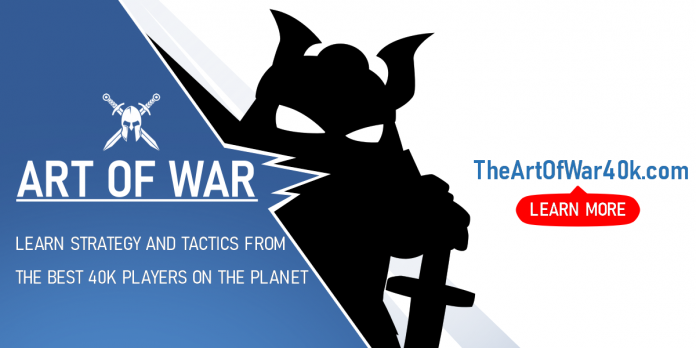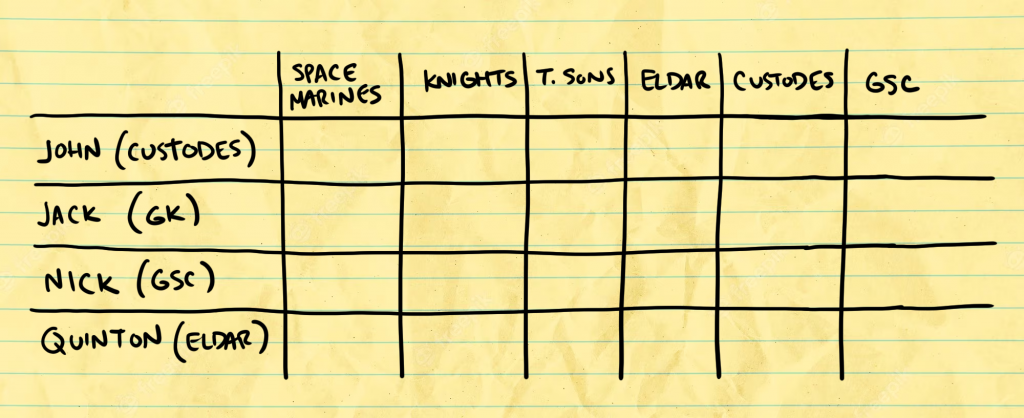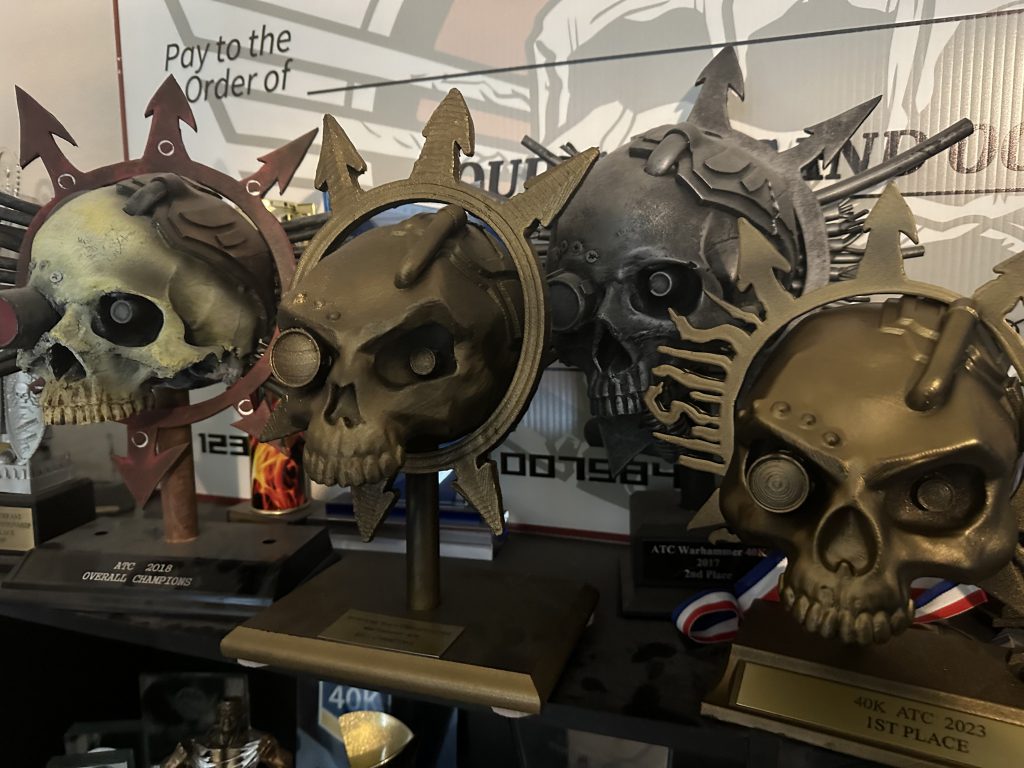The Art of War Team recently won the 2023 American Team Championships, defeating a talented field of teams to win for the second year in a row. We asked the team to write a bit about their experience and how they prepared for the event.
The American Team Championships is a special time of the year for 40k in America. It’s a time of year when approximately 350 gamers gather together in the middle of nowhere for a hot and sweaty weekend to determine which team is the best at competitive 40k. Local teams, organized clubs, and professional teams come out and compete over the course of 6 rounds to win the almighty Servo Skull and take home top bragging rights!
The Team Format
Rob: If you’re unfamiliar with the teams format, it’s a fantastic way to play Warhammer 40k, with a unique way of handling matchups and pairings that dramatically changes the way the game plays and feels You can read more about the teams format and how scoring works in our guide.
In this case, we were the defending champions from last year, and this was the first big 10th edition team event! We wanted to defend our title and prove despite an edition change which really reset the playing field, we were still the best. That and playing in team 40k with your friends is by far the best way to enjoy the hobby in my experience, so why not set up a weekend getaway with the squad!
Speaking of, we had a slight roster change from last year. This yearh our new 5 man team would feature some new blood, with this as our lineup:
- Nick Nanavati (Captain)
- Richard Siegler
- John Lennon
- Jack Harpster
- Quinton Johnson
“His palms are sweaty, knees weak, arms are heavy
There’s vomit on his sweater already, mom’s spaghetti
He’s nervous, but on the surface, he looks calm and ready
– Eminem
This basically sums up Quinton Johnson, our newest team member and MVP of the weekend in a nutshell. This man did in fact drop bombs.
Building the Team
The weeks leading up to ATC were chaotic. Tenth Edition was very new, no one really knew what was good beyond Eldar and Genestealer Cults, and we had no idea if a nerf or weird house ruling would happen in between our prep and the event. Edition changes are just hard like that. So with that in mind we didn’t spend much time figuring out a team composition until just a week or so before lists were due. Instead we spent the majority of our time playing games, learning factions in our various ways working to get a grasp on the meta.
More specifically, I was getting in games here and there where I could. In addition to the stream games I played an average about two games per week with various Chaos armeis and Genestealer Cults. This was good for giving me a good sense of what those armies could do, but it wasn’t a deep understanding at first. Then I took my Genestealer Cults army to a local GT at which absolutely no nerfs were active. We’re talking 370 point Wraith Knights with infinite Fate Dice. Going undefeated at that event really solidified GSC as my strongest faction for me.
Rob: You can find Nick’s list from that event and read a bit more about it in the associated Competitive Innovations in 10th article from that week.
Quinton has always been an Elf boy, and given the inherent strength of Eldar at the moment the faction fit him like a glove. Quinton’s basically played Eldar exclusively for his own practice games since 10th edition has dropped, in addition to playing Eldar on our stream games. He’s also one of the coaches for Team America this year, and thus has gotten a lot of exposure to a variety of factions and ideas through that channel.
John and Jack were the two other fixed pieces of the puzzle. You know the old saying about “having bigger fish to fry?” Well, that basically sums up the ATC for John and Jack – they’re both playing on Team USA at the World Team Championships and so this was practice for them to compete on an even bigger stage. But because they had to play at the WTC, their team preferences were much more important – they’d need to practice with whatever they’d be bringing later, and so our team resolved to allow them to play whatever they were going to take to the WTC, and we’d work around it. As it just so happened, the WTC’s list submissions deadline was the Saturday of ATC, making this very possible without giving anything away*. The big upside for our team is that it meant all the work John and Jack put into testing and prepping for Worlds would be put to use at the ATC as well. Whatever they came up with would be tested and strong.
*Rob: Seriously, WTC teams folks are insane about this shit, terrified revealing a list is going to cost them some key matchup.
And that leaves Richard Siegler, the Robot. In true Richard Siegler fashion, after producing approximately 9,000 hours of content for Art of War he mic-dropped, and went to Brazil for two weeks. He then came back with the exact same complexion and a new set of batteries and hit the grind. Once he’d downloaded every rule in Warhammer into his positronic brain (a process which took about 1.28 seconds), he was ready to take the final spot on the team.
And with that we were ready! Well, kind of…
Event Prep
As the week of list submission drew upon us, we had a small panic, realizing something along the lines of “Oh Shit, we should actually figure this out and build a plan.” We sat down together as a team with some yellow legal pads, official Art of War pens, and got to work planning things out.
- John was playing Custodes at WTC. This made perfect sense – the faction is great, John is great with them, it’s like peanut butter and jelly – two great tastes which taste great together.
- Jack was a bit more of a mystery – he was playing Grey Knights. You see, Jack had been cooking up some big brain plans in his WTC mind kitchen, and had devised a truly devious Grey Knights list. So we decided to roll with it. Unfortunately I can’t reveal too many of its secrets for fear that I’d unveil the mystery before its real debut at WTC.**
**Rob: See? What did I tell you. Insane.
- With John and Jack fixed, my options were limited to Chaos armies and Genestealer Cults. It was pretty clear with my extra GT experience and the faction’s power that I’d end up playing them despite my personal desire to play Kairos Fateweaver.
- Quinton was a no-brainer on Eldar.
- And that once again left Richard. This meant looking at our options and figuring out what the best play was.
Building a Pairings Matrix
Our next step was to plot a pairings matrix. Which is essentially a grid chart with 2 axes. On the Y axis we plotted our existing armies/players, and on the X axis we put theoretical oppositions.
A Rough Example
We basically continued on plotting that X axis with as many credible armies as was reasonable (10 or so) and then we populated each corresponding cell with an expected score between 0 and 20. 0 indicating we will get absolutely murdered, and 20 meaning we will be doing the murdering, with 10-10 being a draw.
This pairings matrix drawn on our yellow legal pad is a key part of planning for a teams event. Going through this process forced us to think about every single match-up as a group and really give an honest assessment of what we expected to score. Then once you have those scores, you zoom out and we could develop a good picture of which armies we were good into and which ones we’d struggle with. That was information we could then use to help us identify what armies we should consider as our 5th option.
We also started plotting Richard’s available factions down so we could see how each of them fared against our theoretical matchups as well as our specific problematic matchups for our team. Our team had a glaring weakness to Genstealer Cults. Richard had Necrons – which are a strong choice – but we found there were just some factions which could crack them, and one of those factions was GSC. We didn’t want to exaggerate our weakness against them, so that put GSC out. T’au were a great choice into Knights, but our team could already wreck Knights, so they were redundant.

Going through the matrix, we arrived at Deathwatch as the best army Richard could play – they were a strong counter to GSC and had a great game against most other factions. The robot changed his settings, downloaded the Index, and that gave us our final roster.
The Event
The overall strategy was essentially to use pairings and clever play to mitigate our opponents’ hardest-hitting factions (such as Eldar and GSC), while lining up at least one of our own hardest-hitting factions for a big win.
In practice this would typically look like us defending with Custodes, which would often draw out Eldar as an Attacker. But with Board choice and very heavy terrain John was often (but not always) able to flip his game against Eldar to a win. We had good GSC counters with my own GSC and Richard’s Deathwatch, which caused many other teams headaches. As far as I can tell, Jack basically just waved his hands and won his games (Rob: The list leans heavily on movement tricks to shift some big, durable bricks around the table)… except for round 1 against Genestealer Cults, a lesson we learned the hard way.
Quinton acted as our Ace in the Hole. We’d line him up into Space Marines without good hiding spots or Orks, and he just never fumbled. His big play moment was his 20-0 win over the Tundra Tactics Genestealer Cults player, which earned him the MVP award for our team.
Rob: You can see Art of War’s lists for the event in our Competitive Innovations in 10th article covering it, along with some thoughts on how each list played.
Final Thoughts
Overall the plan came together very well, with our team finishing 6-0 and as the only undefeated team. We had two close calls, against Death or Glory and Tundra Tactics, both of which were just 1 point away from being draws. It was a really great tournament and a truly fun time. Team 40k still remains my favorite way to play 40k, and I really love this team!
For a full recap of the event you can check out our youtube channel as well as our podcast.
Have any questions or feedback? Drop us a note in the comments below or email us at contact@goonhammer.com.




